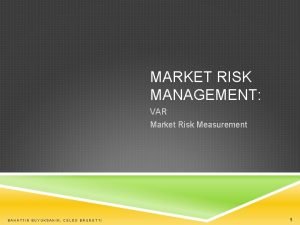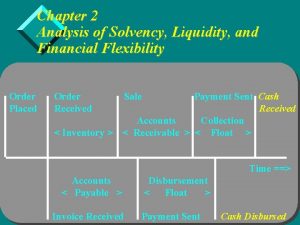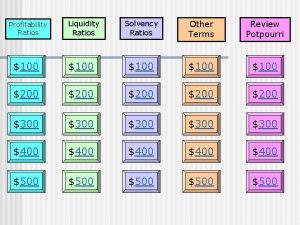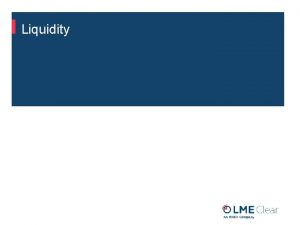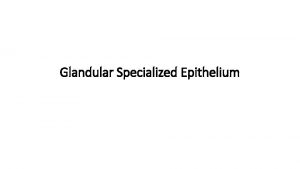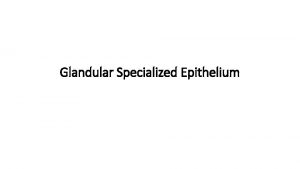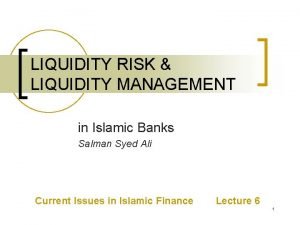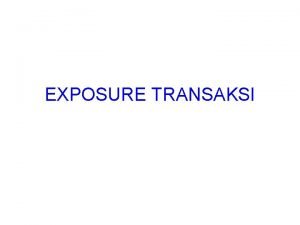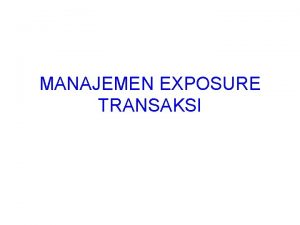Liquidity risk exposure for specialized and unspecialized real



















- Slides: 19

Liquidity risk exposure for specialized and unspecialized real estate banks: evidence from the Italian market Claudio Giannotti, University LUM Casamassima, Bari giannotti@lum. it Lucia Gibilaro, University of Bergamo lucia. gibilaro@unibg. it Gianluca Mattarocci, University of Rome “Tor Vergata” gianluca. mattarocci@uniroma 2. it Milano – June 23 td-26 th , 2010

Index Ø Introduction Ø Literature review Ø Empirical analysis: § Sample § Methodology § Results Ø Conclusions

Introduction § Liquidity is the ability of a bank to fund increases in assets and meet obligations as they come due, without incurring unacceptable losses and the maturity transformation of short-term deposits into long-term loans makes banks inherently vulnerable to liquidity risk (Basel Committee on Banking Supervision, 2008). § The vulnerability of banks toward liquidity risk is determined by the funding risk and the market risk (The Joint Forum, 2006). The funding liquidity risk is caused either by the maturity mismatch between inflows and outflows or the sudden and unexpected liquidity needs due to contingency conditions (Duttweiler, 2009). The market liquidity risk refers to the inability to sell assets at or near the fair value (Matz and Neu, 2007).

Introduction Research question: - Due to the characteristics of the service offered, is there any specific feature for the liquidity of the real estate banks (hereinafter REBs)? - Regulatory provision considers the specific features of the REBs in constructing supervisory rules for the banking system?

Index Ø Introduction Ø Literature review Ø Empirical analysis: § Sample § Methodology § Results Ø Conclusions

Literature review (1/2) The behaviour toward liquidity is affected by firms characteristics: banks liquidity position is affected by both the size, the status type and the product type. The size affects the attitude of the bank toward wholesale funding, including the access opportunity (Allen et al. , 1989) and the price of the funds obtained (Nyborg et al. , 2002). The product type offered to the counterparties, both on the assets and liabilities side, are able to affect the liquidity position: banks that take on demand deposits and offer loan commitments need to hold higher liquid buffers that can be mitigated if a non perfect correlation holds (Kashyap et al. , 2002).

Literature review (2/2) REBs invest in assets that at their origination are illiquid: even though real estates are liquid in the sense of the market microstructure theory, they can fail to provide liquidity when the firm need it (Holmstroem and Tirole, 2000) and, such illiquidity, is affected by the economic cycle (Krainer, 1999). Beyond the illiquidity of the assets at their origination, REBs show an average maturity of assets that is higher than the one of liabilities, even though they show better maturity interest rate gaps than unspecialized banks (Blasko and Sinkey, 2006).

Index Ø Introduction Ø Literature review Ø Empirical analysis: § Sample § Methodology § Results Ø Conclusions

Empirical analysis: Sample (1/2) Database: ABI banking data Time horizon: 2000 -2007 N° of banks in the sample respect to the overall Italian banking sector Frequency of data: yearly Total assets managed by banks in the sample respect the overall Italian banking sector Mean 92% Mean 85% Source: Bank of Italy and ABI banking data processed by the authors

Empirical analysis: Sample (2/2) Following Blasko and Sinkey (2006), we identify REBs on the basis of the ratio between real estate loan. S and total assets (threshold 40%) Number of REBS respect to the overall sample Number of years in which each bank is classified as REBS Mean 47% >= 4 years 55%

Empirical analysis: Methodology (1/3) Threshold 100% Matz and Neu, 2007 The liquidity coverage ratio identifies the amount of unencumbered, high quality liquid assets an institution holds that can be used to offset the net cash outflows it would encounter under an acute short-term stress scenario specified by supervisors. Threshold 100% Duttweiler, 2009 The net stable funding ratio measures the amount of longer-term, stable sources of funding employed by an institution relative to the liquidity profiles of the assets funded and the potential for contingent calls on funding liquidity arising from off-balance sheet commitments and obligations.

Empirical analysis: Methodology (2/3) Item Stock of high quality liquid assets Cash Qualifying marketable securities from sovereigns, central banks, public sector entities, and multi-lateral development banks Qualifying central bank receivables Domestic sovereign or central bank debt in domestic currency In addition, the Committee will gather data on the following instruments to analyse the impact of this standard on the financial sector: Qualifying corporate bonds rated AA or higher Qualifying corporate bonds rated A- to AA-Qualifying covered bonds rated AA or higher Qualifying covered bonds rated A- to AATotal value of stock of highly liquid assets Cash Outflows Retail deposits: - stable deposits - less stable retail deposits [additional categories to be determined by jurisdiction] Unsecured wholesale funding: - Stable, small business customers - Less stable, small business customers [additional categories to be determined by jurisdiction] - non-financial corporates, no operational relationship Secured funding: Funding from repo of illiquid assets and securities lending/borrowing transactions illiquid assets are lent out Amounts receivable from retail counterparties Amounts receivable from wholesale counterparties Implemented proxy Factor applied Cash Government Bonds qualified for refinancing operations by the Central Bank Reserves above the minimum requirement by the Central Bank Domestic sovereign or central bank debt in domestic currency 100% No proxy implementation 80% 60% Deposits minimum 7. 5% minimum 15% Deposits 75% No proxy implementation Retail overdrafts Bank overdrafts 100% LR

Empirical analysis: Methodology (3/3) Available Stable Funding (Sources) Factor Item applied • Tier 1 & 2 Capital Instruments • Other preferred shares and capital instruments in excess of Tier 2 allowable amount having an effective maturity of one year or greater • Other liabilities with an effective maturity of 1 year or greater • Stable deposits of retail and small business customers (non -maturity or residual maturity < 1 yr) • Less stable deposits of retail and small business customers (non-maturity or residual maturity < 1 yr) • Wholesale funding provided by non-financial corporate customers (non-maturity or residual maturity < 1 yr) • All other liabilities and equity not included above 100% Required Stable Funding (Uses) Factor Implemented proxy Item applied • Tier 1 & 2 Capital Instruments • Cash • Short-term unsecured • Other preferred shares and actively-traded instruments (< 1 yr) • capital instruments in excess of Securities with exactly offsetting Tier 2 allowable amount having reverse repo • Securities with 0% an effective maturity of one remaining maturity < 1 yr • Nonyear or greater • Other liabilities with an effective maturity of 1 year or greater 70% 50% 0% Implemented proxy Cash Securities hold for trading renewable loans to financials with remaining maturity < 1 yr Retail deposits 85% NSFR • Debt issued or guaranteed by sovereigns, central banks, BIS, IMF, EC, non-central government, multilateral development banks Retail deposits • Unencumbered non-financial senior unsecured corporate bonds (or covered bonds) rated at least AA, maturity ≥ 1 yr Wholesale counterparties lines • Unencumbered listed equity of credit securities or non-financial senior unsecured corporate bonds (or covered bonds) rated at least A-, maturity ≥ 1 yr • Gold • Loans to non-financial corporate clients having a maturity < 1 yr • All other liabilities and equity • Loans to retail clients having a not included above maturity < 1 yr • All other assets Governement securities 5% Proxy not implemented 20% Proxy not implemented 50% Gold Overdrafts 85% 100% Overdrafts All other assets

Empirical analysis: Results (1/3) Table 1. The relationship between numerator and the denominator of the LR 2000 2001 2002 2003 2004 2005 2006 2007 Overall 0. 5021852 0. 6454966 0. 7204958 0. 6330587 0. 6799326 0. 360547 0. 7816827 0. 4262781 Others 0. 48819 0. 642017 0. 721337 0. 637834 0. 679066 0. 792391 0. 770818 0. 390197 REBs 0. 733977 0. 514405 0. 329857 0. 516824 0. 68357 0. 888516 0. 916589 0. 87259 Mean correlation No REBs = 64% REBS = 68% Table 2. The relationship between numerator and the denominator in the NFSR 2000 2001 2002 2003 2004 2005 2006 2007 Overall 0. 9878589 0. 8834786 0. 9640367 0. 9416667 0. 8333647 0. 7017364 0. 9452888 0. 8810365 Others 0. 988648 0. 881602 0. 973604 0. 953117 0. 81503 0. 94508 0. 946085 0. 881283 REBs 0. 87805 0. 900698 0. 410565 0. 763558 0. 981694 0. 657008 0. 938186 0. 905621 Mean correlation No REBs = 92% REBS = 80%

Empirical analysis: Results (2/3) Table 3. LR statistics for REBs and other banks 2007 Obs. Mean Dev. St. Min Max Wilcoxon H 0: REBs=Others 2006 Mean Dev. St. Min Max Wilcoxon H 0 : REBs=Others 2004 Others 480 REBs 201 Others 501 REBs 173 Others 60 REBs 52 Others 274 REBs 417 0. 041742 4. 002711 -28. 2635 82. 16451 Z 0. 949895 14. 39675 -0. 46581 204. 0404 Prob (Z) -0. 050091 0. 423905 -1. 52095 7. 461202 Z -0. 029173 0. 375364 -0. 73525 3. 298246 Prob (Z) -0. 07065 0. 182969 -1. 35221 0. 152333 Z -2. 528212 18. 11419 -130. 631 1. 218638 Prob (Z) -0. 274128 28. 01242 -177. 177 235. 5864 Z -1. 055678 1. 999414 -25. 2574 16. 10463 Prob (Z) 0. 337 0. 7365 0. 439 0. 6609 1. 202 0. 2294 1. 656 0. 0977 2003 Obs. 2005 2002 2001 2000 Others 295 REBs 396 Others 394 REBs 327 Others 435 REBs 307 Others 406 REBs 324 -0. 779914 22. 52245 -96. 7952 292. 0024 -1. 037483 -1. 578356 18. 6258 5. 325306 -2. 709711 18. 78792 -211. 225 109. 9227 -0. 940388 1. 235592 -6. 3373 8. 247646 -18. 00083 332. 4167 -6909. 37 379. 5905 -2. 822106 32. 92222 -577. 442 4. 947193 -7. 18094 55. 89433 -759. 539 157. 8445 -1. 169203 -. 657854 -19. 5909 3. 772888 Z Prob (Z) -1. 304 0. 1922 -0. 462 0. 6439 -1. 327 0. 1845 -2. 799 0. 0051

Empirical analysis: Results (3/3) Table 4 – NSFR statistics for REBs and other banks 2007 Obs. Mean Dev. St. Min Max Wilcoxon H 0 : REBs=Others 2006 Wilcoxon H 0 : REBs=Others 2004 Others 490 0. 156246 0. 154231 -0. 01469 1. 128477 REBs 204 0. 198587 0. 674863 0 9. 558944 Others 513 0. 026239 0. 073279 0 0. 524784 REBs 176 0. 026075 0. 074239 -0. 00066 0. 438073 Others 63 0. 168163 0. 13683 -4. 2 E-07 0. 493425 REBs 59 0. 243124 0. 176268 0 0. 949356 Others 277 4. 333631 31. 12509 0 441. 6486 REBs 417 1. 103696 0. 341244 0. 058694 3. 083993 Z Prob (Z) -0. 667 0. 5051 0. 135 0. 8928 -2. 411 0. 0159 0. 369 0. 7121 2003 Obs. Mean Dev. St. Min Max 2005 2002 2001 2000 Others 301 1. 345172 21. 54399 -283. 895 236. 989 REBs 396 1. 57536 9. 140028 0. 046824 182. 8631 Others 401 2. 802334 29. 12589 -11. 8329 582. 6147 REBs 328 1. 654038 10. 26566 0. 049221 186. 9272 Others 445 2. 04268 20. 75772 -60. 0217 434. 0665 REBs 307 1. 085733 0. 316148 0. 050401 2. 024204 Others 410 1. 244891 3. 92765 -73. 85 15. 108 REBs 324 1. 158526 0. 366567 0. 05041 2. 542183 Z Prob (Z) 1. 471 0. 1412 -0. 055 0. 956 -0. 537 0. 591 1. 269 0. 2043

Index Ø Introduction Ø Literature review Ø Empirical analysis: § Sample § Methodology § Results Ø Conclusions

Conclusions • Even though REBs bank hold illiquid assets and are featured by an average assets maturity higher than the average liabilities maturity, they do not show to hold a lower level of liquidity with respect to other banks • Especially for REBs that securitize real estate loans, measure to evaluate the liquidity degree of the bank should deserve more relevance to the off balance sheet exposures that are able to drain the liquidity obtained through the sale of the assets and to re –allocate transferred risks back to the originator but potentially under different environment conditions.

Contact information Claudio Giannotti University of LUM Casamassima e-mail: giannotti@lum. it Lucia Gibilaro University of Bergamo e-mail: lucia. gibilaro@unibg. it Gianluca Mattarocci University of Rome Tor Vergata e-mail: gianluca. mattarocci@uniroma 2. it
 Managing economic exposure and translation exposure
Managing economic exposure and translation exposure What is economic exposure
What is economic exposure Managing economic exposure and translation exposure
Managing economic exposure and translation exposure Operating exposure vs transaction exposure
Operating exposure vs transaction exposure Liquidity risk definition
Liquidity risk definition Example of liquidity risk
Example of liquidity risk Liquidity market risk
Liquidity market risk Liquidity measures
Liquidity measures Nature of exposure and risk
Nature of exposure and risk Varieb
Varieb Risk exposure in software engineering
Risk exposure in software engineering Define liquidity financial flexibility and solvency
Define liquidity financial flexibility and solvency Liquid limit flow curve
Liquid limit flow curve Liquidity profitability and solvency
Liquidity profitability and solvency Liquidity planning and managing cash assets
Liquidity planning and managing cash assets Xborder funding mc
Xborder funding mc Solvency ratio
Solvency ratio Liquidity and reserve management
Liquidity and reserve management Maturity matching working capital financing policy
Maturity matching working capital financing policy Residual risk and secondary risk pmp
Residual risk and secondary risk pmp




